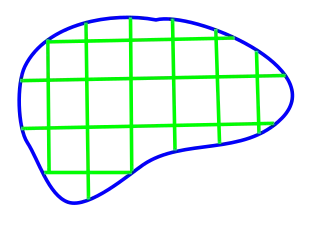Mtg 6: Sun, 16 Jan 11
page6-1
Proof of Taylor series continued
Since
![{\displaystyle \displaystyle \int _{x_{0}}^{x}{f}^{1}(t)dt=[{f}^{0}(t)]_{t={x}_{0}}^{t=x}}](../../../885a768c6be62b5a5248d414f82cceb7ee3da619.svg) |
(1) |

Int. by parts (1)
![{\displaystyle \displaystyle \color {red}(2){\begin{cases}&\ \color {black}\int _{x_{0}}^{x}\color {blue}{\underset {u^{'}}{\underbrace {1} }}{\underset {v}{\underbrace {\color {black}{{f}^{(1)}(t)}} }}\color {black}dt={[uv]}_{x_{0}}^{x}-\int _{}^{}{uv}^{'}\\&\ \color {black}={[tf^{(1)}{t}]}_{t=x_{0}}^{t=x}-\color {blue}{\underset {\alpha }{\underbrace {\color {black}{\int _{x_{0}}^{x}tf^{(2)}dt}} }}\\&\ \color {black}=xf^{1}(x)-x_{0}f^{(1)}(x)0)-\color {blue}\alpha \\&\ \color {red}+\color {blue}xf^{(1)}(x_{0})\color {red}-\color {blue}xf^{(1)}(x_{0})\\&\ \color {black}=\color {blue}{\underset {\int _{x_{0}}^{x}xf^{(2)}(t)dt=:\beta }{\underbrace {\color {black}[xf^{(}1)(x)-xf^{(}1)(x_{0})]} }}\color {black}+(x-x_{0}){f}^{(1)}(x_{0})-\color {blue}\alpha \end{cases}}}](../../../c9352137bf8a1253db8be1f4ff808de5fb3c85fe.svg)
page6-2
Combine [ + β - α] into a single int.
use (2) p.6-1 in (2) p.5-3:
 |
(1) |
HW*2.1: 1) Do integration by parts on last term (integration) of (1) to reveal 3
more terms in Taylor series, i.e. ,
 |
plus remainder
2)Use IMVT to expression remainder in terms of f(s)(ξ) for s belong[x0,x]
3) Assume(3)&(4)p.3-3 correct , do intergration by parts once more
page6-3
to verify(3)&(4) p.3-3 for (n+1) expansionwith R(n+2)(x)
4) UseIMVT on(4) p.3-3to show(5)p.3-3
IMVT:
![{\displaystyle \xi \in [a,b]}](../../../6cc05d1fb45b90e25c99bc6a57473d508d3e9c23.svg)
Use "g(x)" instead of "f(x)" to avoid confusion with "f(x)" is a Taylor Series. |
|
HW*2.2:![{\displaystyle f(x)=sinx,x\in [0,\pi ]}](../../../3bef75bee927386b2ff508a6c754ff5ebdea9429.svg) Constrast Taylor Series of f(.) around
Constrast Taylor Series of f(.) around
 for n = 0,1,2,...,10
for n = 0,1,2,...,10
Plot these series (for each n) Find (estimate) max 

page6-4

![{\displaystyle \color {blue}{\underset {\leqq 1(f(x)=sinx)}{\underbrace {\color {black}t\in [{x}_{0},x]} }}}](../../../4028b1ca0537e34a7778da8576126aad7209b696.svg)
Note:Motivation for pf of Taylor series expansion. (similar technique will be used)
- higher order analysis of Trap. rule (not in A.)
- Richardson extrap.
- clenshaw-Cwetis quadrature
- chebyshew poly (orthog.) Recent devel. using chebyshew poly to solveL2_ODE_VC (Linear 2nd order ODE with varying coefficient ) combine of symbolics + numericsReference : Trefethen's chebfun.
page6-5

